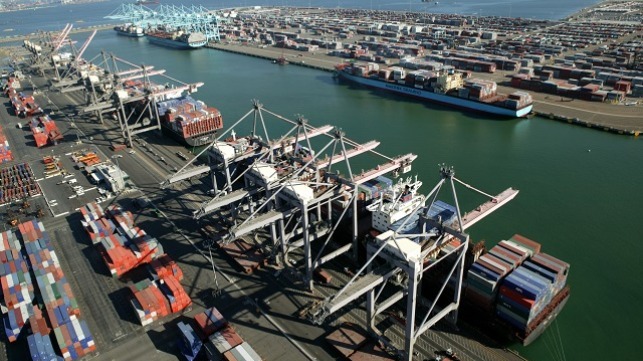June Volumes Declined at Los Angeles as Port Predicts Moderation

The Port of Los Angeles reported declines in volumes during June largely in line with expectations. While the levels remain significantly below both last year’s record month and forecasts, the port believed there were some signs of moderation in the declines.
“Given the circumstances of an unresolved trade war and an ongoing pandemic, our June and mid-year cargo volumes are in line with our forecasting,” said Port of Los Angeles Executive Director Gene Seroka. “Our focus now is on enhancing the port’s competitiveness with infrastructure, technology, and operational efficiencies as we help get Americans back to work and drive economic recovery.”
Volumes in the Port of Los Angeles were down nearly 10 percent in June with 691,475 TEUs compared to last year’s record-setting June. For the first half of 2020, overall cargo volumes have decreased by just over 17 percent. As expected, automobile volumes turned negative due to the slowdown in sales, while scrap metal and steel volumes are hampered by tariffs, and petroleum volumes declined as fewer people traveled due to the pandemic and the stay home orders.
June’s loaded imports decreased by nearly seven percent while loaded exports dropped more than 21 percent versus the year ago. Despite these declines, the port’s executive director said during his briefing that the results were in line with their expectations due to trade issues and the pandemic. Specifically, he mentioned that trade was falling short of the goals set in the Phase 1 trade agreement between the U.S. and China, which is contributing to the declines in exports.
Despite the decline, the Port of Los Angeles is still moving 80 to 85 percent of its normal trade volume for this time of year and has not missed shifts due to the pandemic. Labor shift work, however, is down about 18 percent due to the lower volumes but has not outpaced the cargo volume declines.
The port points to a few developments that could signal a leveling off in volumes. Specifically, they are starting to see the evacuation of empty containers from the port preparing possibly for a modest uptick in imports. Over 200,000 empty TEUs moved through the port in June, which was down approximately seven percent versus 2019. Retailers they believe are starting to replenish distribution channels that could contribute to the import volumes. However, expectations are for continued soft consumer sales meaning that they are not expecting strong increases leading into the traditionally busy fall holiday retail selling season.
The port also highlighted that the liner companies are balancing supply with demand leading to a leveling off in the number of vessel arrivals. In the first three months, the Port of Los Angeles experienced 40 canceled voyages, down to 23 cancelations in the second quarter. In both July and August, they are expecting just two canceled sailings per month.
For the year, the Port of Los Angeles announced that they were projecting 7.9 million TEUs in volume which would represent a 15 percent decline from the 9.3 million TEUs that moved through the port in 2019. The port’s long-term goal is for 10 million TEUs, which the port’ executive director feels could be achieved through opportunities in exports if the U.S. is successful in fixing its current trade issues.
The focus remains on the longer-term issues necessary to slow the port’s decline in market share. The port has not been keeping up with national growth rates and since the work stoppage in 2002 has experienced a 20 percent loss in market share. Charges in trade and shipping patterns the port believes could contribute to an additional 15 percent decline as more goods flow from Southeast Asia via the Suez Canal to the U.S. East Coast ports.
During the news conference, Seroka praised the Federal Maritime Commission and Federal Maritime Commissioner Rebecca Dye for suggestions to further improve cargo fluidity in the San Pedro Bay. He highlighted that the Port of Los Angeles is operating very efficiently with truck turnaround times averaging less than 60 minutes, the lowest levels in the eight years turnaround times have been tracked.
The port is also well prepared to handle the larger container ships and in fact set a record for the number of containers handled from a single vessel in June. Initiatives are underway looking at both the port and the region's competitiveness issues along with plans to further enhance the port’s position and longer-term to attract volume.
